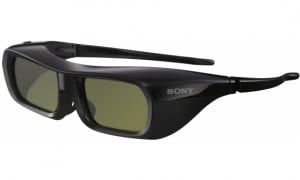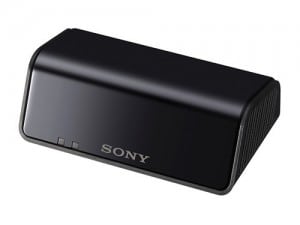TWO TYPES OF 3D GLASSES FOR THIS SONY
Here's the scoop. Sony is providing two pair of 3D glasses with the projector. They are infra-red type glasses, as was typical until really the last year or so. Most companies have been moving to using RF (radio frequency). In this case, Sony's at the "half-way" point. IR glasses are free, and the IR emitter is built into the projector.

People may not look great wearing 3D glasses like these Sony's, but 3D does look great on this Sony projector!
The newer glasses, the RF types however are optional, and need an external emitter (TMR-RF1), also optional. The newer, lighter RF glasses (TDG-BT500A) are lighter and likely more comfortable but we didn't have the ability to compare them side by side. That said, as other companies have done the same thing, we have been able to compare older IR and newer RF glasses before, just not Sony. RF is the way to go, and there's a huge benefit if you do. Their RF glasses are compatible with other projectors, and some LCDTVs. While projector manufacturers set their glasses prices pretty high, there are some very low cost ones. There are inexpensive Samsung glasses that I use with the Epsons that will also work with the Sony RF setup. I know, because I've used the Epson glasses with the Sony, with one of Sony's 4K projectors, the VW6000Es.
SONY Wireless HDMI Option
The concept of wireless HDMI is a great one. If you are installing a projector, such as ceiling mounting, you do have to get your power to the projector. But you also have to get your sources there. Today, HDMI is the standard. The issue is that whether your projector, if permanently placed, is ceiling mounted, or on a high rear shelf, you also have to get your sources hooked up. Unfortunately they are usually not near by. Most folks will want to run the wires through the wall, and that means a lot of installation and cable running. By comparison, getting power to the projector is simple and closer. Thus, having a wireless HDMI solution can mean not opening up a couple of walls to run wire, not spending many hundreds of dollars to installers for doing that.

Sony's optional wireless HDMI module. The receiver side plugs right into one of the HDMI inputs, just as a 3rd party solution would.
We did not have the opportunity to test the Sony IFU-WH1 wireless HDMI rig with its multiple HDMI inputs, but we have reviewed several stand alone ones, and also one similar solution from another projector company - in that case Epson. In all cases, the signal has appeared clean under normal use (reasonable distances). (I even just received another one, this time from DVDO, to review.)
But there are limitations. For those of you used to the time it takes to get your projector or TV to start up a Blu-ray disk, for example, the source keeps changing resolutions and settings. Add to that HDCP - the Blu-ray copy protection scheme, which really slows such things down, and we are used to flashes, or messages, repeatedly, and it may often take 4 to 10+ seconds to get a real image on the screen, where that HDCP is in use. At least we see the flashes, the messages, etc., when hard wired. With wireless HDMI, things move slowly enough that you don't get all those intermediate things happening. Mostly, I've found, you see about nothing, until the the image appears. Thus, it's the inconvenience of waiting, without the usual things happening that tell you that it's working. In other words after 5 or 7 seconds you start wondering. Well, my experience is that it will work, and it won't really take longer, you just won't know exactly what's going on. Like most wireless HDMI offerings, the Sony's is lossless, the picture quality should be identical to using a good quality, expensive cable.
So, the Wireless HDMI is a great additional feature for the Sony VPL-HW55ES. Most folks probably don't need it, but if wireless HDMI beats opening up more walls, and more installer expense, it's a great thing to have. And since it's optional, you aren't really paying for it if you don't need it.
Sony Motion Enhancer - Creative Frame Interpolation
Motion Enhancer control is found on the Motionflow sub-menu off of the main Picture menu. It is one of two features there, the other being Film Projection, which is the 3:2 pull-down feature (when On), and does 24 fps, when off.
Selecting Motion Enhancer gives you three choices, Off, Low, and High. This is your creative frame interpolation (CFI) otherwise referred to as "smooth motion".
Overall, CFI which I don't use with movies, is very smooth, artifacts around moving objects are very hard to spot, even in the high setting.
The Sony projector has 240 frame per second capabilities, that allows a lot of creativity when working with 30 or 60 fps source material. Black frames can be inserted or new frames that fall between original ones that interpolate the motion.
Overall, I'd say this is one of the better CFI's around. CFI is a nice touch to have. I will use it if I remember, for my sports. Some folks will think it more important than I do. I figure if a projector has it, and it works well, it's one of those pluses. From there the user decides whether they like it or not. Although it works very well, if this Sony VPL-HW55ES projector didn't have Motion Enhancer, it wouldn't affect my favorable opinion of this projector.




